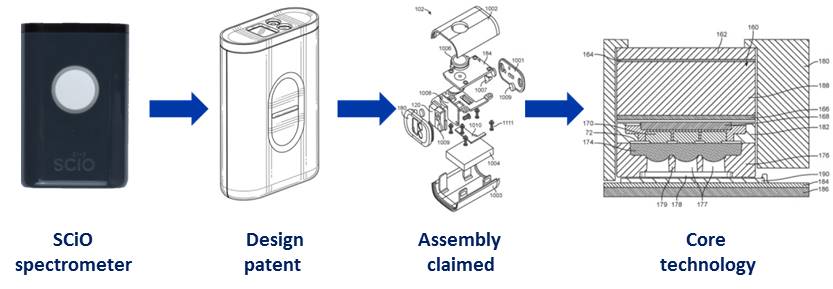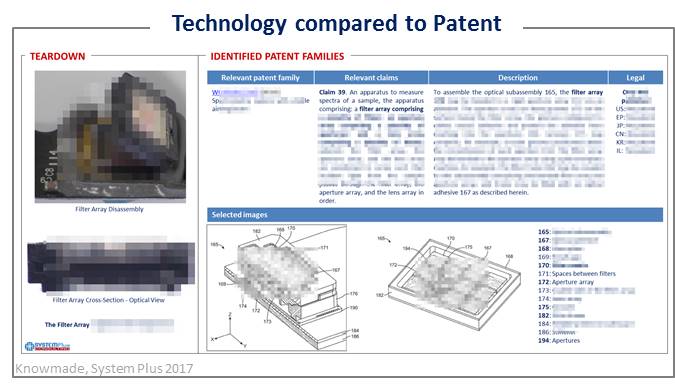For a long time, spectral analysis of materials has been limited to academic research. Everyday application of this type of analysis could bring new interactions in areas including food, fitness and medication. Starting with a crowdfunding campaign, and following the path of companies like FLIR, Consumer Physics, which was formerly Verifood Ltd., has created the first dongle molecular sensor, the SCiO Spectrometer. Thanks to big data and cloud technology, the dongle spectrometer claims to take the spectral fingerprint of any substance and quantify or identify any compound. Consumer Physics has won numerous awards, has regularly appeared in top ‘products to watch’ lists on Forbes, CNN, and Fortune, and has been covered numerous times by the media on television, in print and online.
KnowMade and System Plus Consulting, both part of the Yole Group of companies, has investigated the technologies behind Consumer Physics’ success and the main features claimed by its patents. You can read their findings in their new reports SCiO Molecular Sensor from Consumer Physics: Mobile Spectrometer Dongle and Consumer Physics SCiO Molecular Sensor Patent-to-Product Mapping.
Yole Développement interviewed the two author companies to find out what we can expect from this product. Read on to find out more.
Yole Développement: Why did you choose the SCiO spectrometer for teardown, reverse costing and patent analysis?
KnowMade and System Plus Consulting: Spectrometry has long been reserved for research. Its application can theoretically allow the identification of every compound in the world. For consumers, we imagine that this could provide interesting information on foods, drugs or, with a special calibration, total body fat. Consumer Physics has provided the first spectrometry physics product for consumers. It can be held in one hand and offers basic information on every sample. It doesn’t pretend to beat larger spectrometers, but the resolution is enough for consumer applications. As the first spectrometer dongle, and because of its recent integration in a smartphone, System Plus Consulting decided to do reverse costing analysis on the system and the spectrometer head.

YD: What is special in the design and manufacturing technologies used by Consumer Physics in the SCiO? What are the key innovations?
KM & SPC: The main innovation behind the SCiO is the simplicity of the manufacturing. The optical network and light sensor has been replaced by an interferometer grid and image sensor. In this configuration, absorption of visible and near infra-red light is measured at the same time. Also, as interpreting molecular structures from the spectra isn’t simple Consumer Physics integrates a cloud database that compares a huge number of spectra to identify compounds. In the system, Consumer Physics bases its chipset on Analog Devices technology, which suggests a further partnership for more integrated solutions.
YD: How are these innovations covered in the patent portfolio of Consumer Physics?
KM & SPC: Consumer Physics, under the name Verifood, owns 12 patent families related to the SCiO technology. This patent portfolio is recent, with an international IP strategy. The patented technologies of the pocket-sized spectrometer are mainly related to the spectrometer module, and more particularly to the filter array and the lens array.
YD: What are the applications for such devices?
KM & SPC: The dongle itself could already be used in several applications. Coupled with a smartphone, consumers can identify calorie, fat and sugar content or any compound in food. It can also identify specific liquids, or tell you if the pills in an unmarked bottle are vitamins or a prescription pain killer. Also for fitness applications, people can measure and follow their body fat and composition.
YD: Are there other devices available on the market?
KM & SPC: SCiO was the first pocket-sized molecular sensor in the market but not the first handheld spectrometer. The spectrometer head integrated in the system has several competitors like:
• The Texas Instruments DLP NIRscan Nano based on a digital micromirror and a diffraction grating
• The NeoSpectra Micro SWS62231 in one MEMS chip operating in the near-infrared spectrum
• The Hamamatsu C12666MA operating in the visible spectrum
YD: How can we expect the market to evolve, and what new applications might there be?
KM & SPC: Since collaborating in early 2016, Analog Device and Consumer Physics plan to miniaturize the SCiO sensor for integration into a wide variety of connected devices. For example, these companies are developing, in collaboration with Sichuan Changhong Electric, a smartphone with an embedded SCiO molecular sensor, named Changhong H2. The Changhong H2 was presented during CES 2017 in Las Vegas and according to Changhong this smartphone will hit China in the first half of this year and the US in late-2017. In smartphones, this technology could become a standard device like the heart rate sensor in the Samsung Galaxy Series. But other OEMs could also be interested in this kind of microsystem. We can imagine kitchen scales analysing and weighing the product at the same time and a refrigerator that could analyse and report the healthiness of vegetables or any food.
Access all our patent landscape reports about healthcare right here.
Press contact
contact@knowmade.fr
Le Drakkar, 2405 route des Dolines, 06560 Valbonne Sophia Antipolis, France
www.knowmade.com
About our analyst
Olivier Thomas, MSc, Olivier works at Knowmade in the field of Biotechnology and Life Sciences. He holds an MSc in Molecular and Cellular Biology from Paris VI University (France). He also holds an Industrial Property International Studies Diploma in Patents and Trademarks from the CEIPI (Strasbourg, France).
About Knowmade
Knowmade is a Technology Intelligence and IP Strategy consulting company specialized in analysis of patents and scientific information. The company helps innovative companies and R&D organizations to understand their competitive landscape, follow technology trends, and find out opportunities and threats in terms of technology and patents.
Knowmade’s analysts combine their strong technology expertise and in-depth knowledge of patents with powerful analytics tools and methodologies to turn patents and scientific information into business-oriented report for decision makers working in R&D, Innovation Strategy, Intellectual Property, and Marketing. Our experts provide prior art search, patent landscape analysis, scientific literature analysis, patent valuation, IP due diligence and freedom-to-operate analysis. In parallel the company proposes litigation/licensing support, technology scouting and IP/technology watch service.
Knowmade has a solid expertise in Compound Semiconductors, Power Electronics, Batteries, RF Technologies & Wireless Communications, Solid-State Lighting & Display, Photonics, Memories, MEMS & Solid-State Sensors/Actuators, Semiconductor Manufacturing, Packaging & Assembly, Medical Devices, Medical Imaging, Microfluidics, Biotechnology, Pharmaceutics, and Agri-Food.
